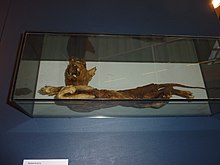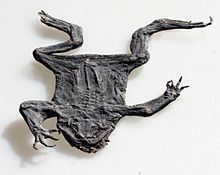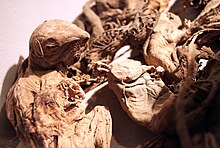Mummification
As mummification is called the natural running process of long-term corpse preservation , the formation of mummies leads. Its investigation is part of the fossilization theory . Mummification, as a natural form of corpse modification and preservation, is not identical to human-operated mummification .
requirements
Due to special external circumstances such as strong solar radiation, dry and cold drafts or rapid embedding in a toxic environment, both putrefaction and putrefaction are sometimes stopped early. One then speaks in the broadest sense of mummification, which is characterized by the preservation of soft tissues, proteins and sometimes also cell structures.
- Cold mummies
- Dry mummies
- Poison mummies (especially bitumen deposits)
- Wax corpses
Mummification can only preserve carcasses of varying quality for tens of thousands of years, but it is sensitive to various geological processes such as increasing rock pressure or higher temperatures. If the mummy is stored on the earth's surface, it usually disintegrates quickly, weathered or is destroyed by microorganisms .
They are therefore found increasingly less in older deposits, but become more common the closer they are to the present. Older mummies often undergo a gradual change of substance in the rock, a metamorphosis, in the course of which the original substance is chemically changed, so that a longer-lasting fossil is created. The soft tissues are clearly visible on this, but cell structures and typical organic substances are missing. As mummy pseudo metamorphoses refers mummies whose original substance was completely decomposed after the storage, and a void was created, which is then filled with inorganic material. A fossil is then created that fills a cavity like a plaster cast. Imaging procedures (X-ray, etc.) then show that the internal structure has nothing in common with the original structure of the formerly mummified organism. Nevertheless, these fossils are valuable because they show the outer outlines of the living being - which is rarely the case with direct embedding.
The well-known Anatosaurus "mummies" from the North American chalk of Wyoming , South Dakota and Canada are an often cited example of this. On a cursory glance, they give the impression that they are real mummies, but consist of inorganic crystal structures through and through.
Cold mummies
Cold enamel is the most efficient way to keep your body healthy, because fungi and bacteria need warmth in order to develop. Today forensic medicine specifies the optimum between −21 ° and −38 ° C. From refrigerator temperatures of 4 to 3 degrees Celsius, the activity of the microorganisms comes to a standstill. Cold mummies known as ice mummies are created both by natural freeze-drying, in which the body moisture evaporates and the tissue dries out, and by the gradual loss of the moisture contained in the body with the formation of an ice lens surrounding the carcass. Both processes can delay the biological degradation process for thousands of years.
In the Siberian ice of the permafrost , for example, some large Pleistocene mammals ( mega-faunas ) from the mammoth steppes have survived so well that their internal organs , muscles and even blood can still be eaten by foxes , wolves and dogs . Such findings are of particular value if cell structures have been preserved, on which cytological and histological examinations provide information about the differences between the cells of these animals and today's animals and allow careful estimates about the physiology of the extinct animal species. The genes can also be preserved. Recently, therefore, considerations have been made as to whether it would be possible to bring extinct animal species back onto the scene with genetic engineering methods ( cloning ), but due to the breakdown of DNA after the death of a living being, such efforts have not yet been successful . In 1977 it was possible for the first time to isolate a protein from the muscle tissue of a woolly mammoth ( Mammuthus primigenius ) found in Fairbanks ( Alaska ) , which allowed an exact relationship to recent elephants to be determined. It turned out that the protein found in the mammoth (an immunoglobulin ) to its counterpart in the Indian and African elephants has about the same degree of relationship as the globulins of the two recent elephants. The molecular biological proof of the close relationship of these animals was provided. The best-known ice mummy is the "man from Tisenjoch" in the Ötztal Alps , often called " Ötzi ". Further examples are the roughly 39,000 year old body of the woolly mammoth calf “Dima” from Northeast Siberia or the roughly 35,000 year old carcass of the steppe bison “ Blue Babe ”.
Dry mummies
Rapid dehydration, which can occur through dry, warm air, direct sunlight, as well as moving cold, dry air, produces durable mummies (see also baked fruit or dried fish ). The surface of the organisms dries out quickly, solidifies and prevents renewed absorption of water. Inside this sealed carcass , moisture lingers longer and can turn into putrefaction . Often, however, further transformation processes prevent this, for example when substances with a necrotic effect arise. Most of the time, however, organs dissolve, for example the digestive system with self-digestion or the liver with enzymatically induced decay.
Dry mummies can be found in closed rooms but also in loose dry soil ( peat ). Characteristic of this mummy formation is a dorsal curvature of the spine, which is caused by the shortening of the muscles during drying . This curvature can also be used to tell from fossilized fossils that the carcass was mummified before it was embedded. The head and neck bend backwards, mostly down to the back of the body. This curvature thus indicates immediate post-mortem dehydration, the animal was probably in a habitat in which it may have died of thirst. Dry mummies arise in deserts or under other circumstances through rapid drying out, as was most likely the case with the corpse of Christian Friedrich von Kahlbutz ("Knight Kahlbutz").
Salt mummies
A hygroscopic environment, such as that created in the presence of dry salts, is particularly effective . Storage in salty historical solutions that soak the carcass and prevent bacterial growth also preserves the soft tissues. Salt ponds offer ideal conditions for the preservation of the soft tissues: the salt strives for osmotic balance and diffuses into the tissue, in which it brings bacterial growth to a standstill (see also curing ). Well-known salt mummies come from the historic salt mines in Hallein (Austria) or Cherābād near Zandschan (see salt mummies from Zanjan ).
However, fossils are seldom formed from salt mummies. In a pure salty environment, aggressive processes quickly set in motion which lead to complete disintegration. The mighty salt deposits of the Zechstein seas (Flöz Hessen, Flöz Thuringia), which consist of sodium and potassium salts, show no fossils.
Poison mummies
Very well-preserved mummies also develop in media in which substances with a necrotizing effect are present, which kill all or some of the microorganisms.
Bog corpses occur in raised bogs. In the moor, tannins from decaying plant parts and the lack of oxygen prevent the growth of many microorganisms. However, if these bog corpses are not subjected to any further fossilizing influences, they will decay over time and will not be preserved - especially if the bog remains moist and does not dry out beforehand.
Animals often sink into naturally formed bitumen or paraffin pools , which act like traps and in which the bodies are completely separated from the air supply. If there is no salt in addition to the oily mass , the soft tissues are not preserved because they are liquefied from the inside by the anaerobic intestinal bacteria. If the salt concentration is too low at the beginning, putrefaction starts from within. If it does not drop later, the body is destroyed by crystallization processes .
Wax corpses
A wax corpse is created by excluding oxygen. The exclusion of oxygen prevents decomposition processes from taking place. The putrefaction processes that take place inside the body, which take place without oxygen with the help of the body's own enzymes, are also stopped by the waste products that they produce themselves and that cannot escape (e.g. ammonia). This will preserve the corpse. It is reported that in some German cemeteries mummifications occur on corpses buried in coffins. This poses a problem because they do not decompose in the allotted time, but the cemetery place has a fixed length of time and should then be released. In the case of burial in the ground, the exclusion of oxygen and thus the undesirable formation of wax corpses comes about, for example, because the death's dress is made of synthetic fibers and fits tightly or the soil is not permeable to air (e.g. clay soil). The premortal intake of antibiotics or low doses of ionizing radiation also promote mummification as wax corpses. A prominent example of mummification by excluding oxygen is the Marquise of Dai .
Mummified forest
Stone embryos
See also
literature
- Arno Hermann Müller: Textbook of Palaeozoology , Gustav Fischer, 1992
- RG Bromley: Trace Fossils - Biology, Taphonomy, Applications . Springer, Berlin 1999. ISBN 3-540-62944-0
- RL Lyman: Vertebrate Taphonomy . Cambridge University Press, Cambridge 1994. ISBN 0-521-45215-5
- RE Martin: Taphonomy: A Process Approach (Cambridge Paleobiology Series) . Cambridge University Press, Cambridge 1999. ISBN 0-521-59833-8
Individual evidence
- ↑ With mushrooms to eternal rest . In: Die Zeit , No. 15/2007
- ↑ Tired floors, tough corpses . In: Die Zeit , No. 45/2003




